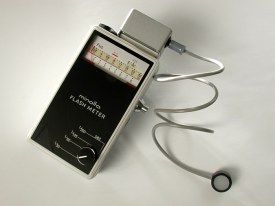Completely off topic (2)....?
Minolta original flash meter

Minolta Flash meter (1969)
|
Certainly off topic....but fun.
In between editing the site, I've acquired this Minolta flash meter from 1969, complete with synch cord (never used and probably already worth the greens I've paid), manual and ND filter.
Aware of this meter since I studied on the Photo Academy, it was far beyond my reach in that time, I felt some quickening of the blood when spotting it on E-bay...
This was the very first professional flash meter. Actually a misnomer as ambient light can be measured also.
The meter can read reflected light (10 deg) and incident light with or without sync cord. The meter was in almost pristine condition. There could be a problem however, meters from this era used mercury 1.35 V exclusively.
The substitute alkaline 625 1.5 V could give problems, but it did not.....The meter is dead-on compared to my Minolta IV.
|

Minolta Flash meter (1969) Front-view
|
View from the measuring front.
Once the reflected light receptor view finder is attached the incident light receptor (dome) is disconnected.
The images will show its almost mint state the meter is in.
|

Minolta Flash meter and optional accessory.
|
Minolta Flash meter and optional accessory:
Accessory Connector Shoe
Mounted - Micro Disk Receptor
The receptor is mainly used when light is too weak for measurement with the flashmeter dome.
|

Minolta Flash meter (1969) Front-view & back view
|
On the left: Correct (Incident light) position to point to the camera.
On the right: Correct position (Reflected light) when pointing to the subject with the 10 deg viewfinder
It is very nice to handle this meter and certainly will cause raised eyebrows with my colleagues but... what the heck!
|

Optional accessories in Minolta Box (1969)
|
Miscellaneous accessories acquired some time later:
- Minolta accessory box
- Accessory connector shoe
- 4 EV ND filters for both incident and reflected light
- Flat diffusor
- Micro-Disk receptor LH2 5 LV more senstive than incident light receptor
|

Original sales brochure (1969)
|
Copy from the sales leaflet 1969.
The meter was #1 choice till 1975 for professional Studio use, followed by the Minolta flashmeter II (1975-1979), Minolta Flash meter III (1979-1985 Probably the most respected Flash meter ever), Flashmeter IV (1985 - 1995), Flash meter V (1995-2002) and the Flash meter VI (2002 - a little short of forever?).(Minolta Co Ltd and later Konica Minolta has stopped production of cameras and meters for the photographic market.)
- Ref view finder
- 4 EV ND filters for both incident and reflected light
- Spherical and flat diffusors
- Pin point receptor - measuring GG
- Micro-Disk receptor
For some reason I kept this leaflet for many years in my archives.
|





